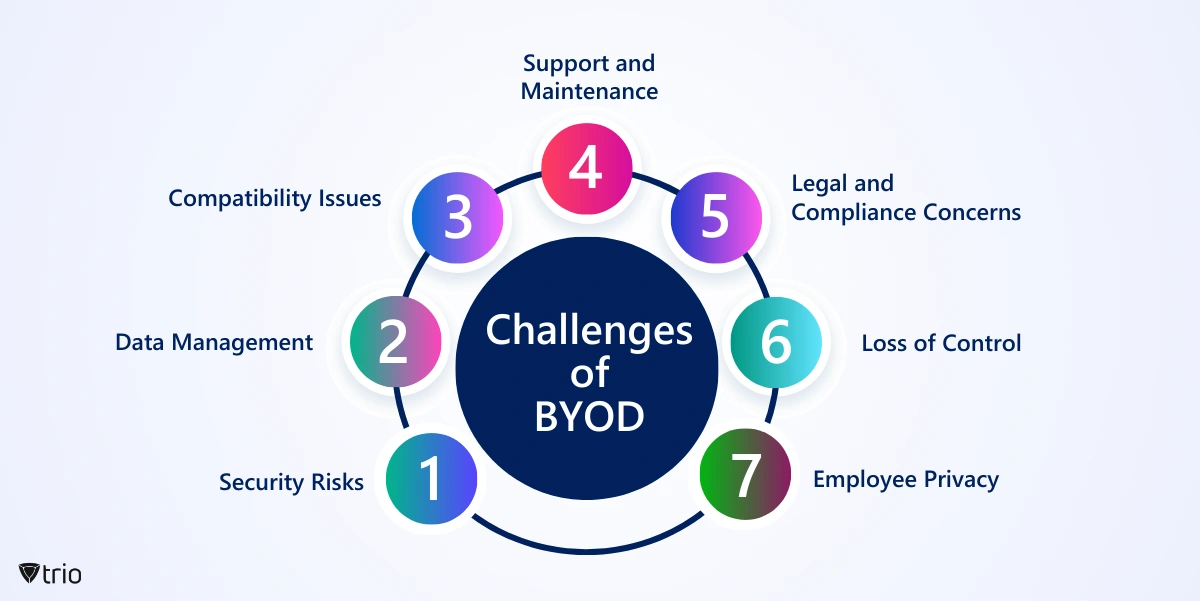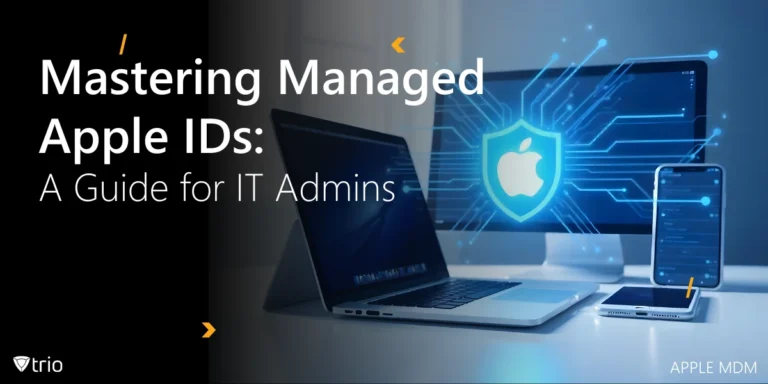The concept of Bring Your Own Device (BYOD) has become increasingly prevalent in both corporate and educational environments. According to Research and Markets, ” The global market for BYOD and Enterprise Mobility estimated at US$84.4 Billion in the year 2022, is projected to reach a revised size of US$296.4 Billion by 2030.” This is because BYOD offers several potential benefits. However, along with these benefits come various challenges. Organizations and institutions must address BYOD challenges to ensure its successful implementation. In this blog post, we will explore the challenges that organizations face regarding BYOD and how they can solve them.
What Is BYOD?
According to a survey performed by Cybersecurity Insiders, over 80% of organizations use BYOD. So, if your organization isn’t familiar with the concept, it should start right now. BYOD, or Bring Your Own Device, is a policy in workplaces or educational institutions that allows employees or students to use their personal electronic devices, such as laptops, smartphones, or tablets, to access company or school networks and resources. Instead of relying solely on company-issued or institution-provided devices, BYOD policies enable individuals to use their preferred devices for work or study purposes.

The Upside of BYOD
The upside of BYOD (Bring Your Own Device) includes several potential benefits for both employees/students and organizations/institutions:
- Cost Savings: Companies and institutions can save money by not having to purchase and maintain as many devices for employees or students. Instead, individuals use their own devices, reducing the organization’s hardware expenses.
- Increased Productivity: Employees or students often prefer using their own devices, which they are already familiar with and comfortable using. This familiarity can lead to increased productivity as individuals work more efficiently on devices they know well.
- Flexibility and Convenience: BYOD allows individuals to choose the devices that best suit their needs and preferences, whether it’s a specific brand, operating system, or form factor. This flexibility can contribute to greater satisfaction and morale among employees or students.
- Access to Latest Technology: Personal devices are often more up-to-date than company-issued or institution-provided devices, allowing individuals to leverage the latest technology and software tools to perform their tasks more effectively.
- Work-Life Balance: BYOD blurs the lines between work and personal life in a positive way by enabling individuals to use their devices for both work and personal tasks. This can contribute to a better work-life balance as individuals have more control over when and where they work.
- Potential for Innovation: By embracing a diverse range of personal devices, organizations and institutions may encourage innovation and creativity among employees or students, who may discover new ways to utilize their devices for work or study purposes.

BYOD Challenges and Concerns
Even if businesses adhere to BYOD best practices, they are also several challenges that organizations and institutions must address:
-
BYOD Security Issues
Personal devices may not have the same level of security measures as company-issued or institution-provided devices. This is one of the vulnerabilities of BYOD since it leads to an increased risk of data breaches, malware infections, and unauthorized access to sensitive information.
-
Data Management
Managing company or institutional data on personal devices can be challenging. Organizations need to implement robust data management policies and solutions to ensure data security, privacy, and compliance with regulations.
-
Compatibility Issues
Different devices, operating systems, and software versions may not always be compatible with each other or with the organization’s or institution’s systems and applications. This can lead to interoperability issues and hinder productivity.
-
Support and Maintenance
Device provisioning and supporting a diverse range of personal devices can strain IT resources. IT departments may struggle to provide technical support, troubleshooting, and maintenance for a variety of devices, leading to increased workload and costs.
-
Legal and Compliance Concerns
One BYOD risk is that it raises legal and compliance issues related to data protection, privacy regulations, and intellectual property rights. Organizations and institutions must establish clear policies and procedures to address these concerns and ensure compliance with relevant laws and regulations.
-
Loss of Control
Allowing employees or students to use personal devices for work or study purposes means relinquishing some degree of control over those devices. Organizations and institutions may find it challenging to enforce policies, monitor usage, and ensure adherence to security protocols.
-
Employee Privacy
BYOD policies raise concerns about employee privacy, as organizations may need to implement monitoring and tracking mechanisms to ensure security and compliance. Balancing the need for security with respect for employee privacy can be a delicate task.

How Trio Can Help With BYOD in Your Organization
An MDM (Mobile Device Management) solution can help organizations and institutions address BYOD threats and vulnerabilities by providing centralized control and management of mobile devices, including personal devices used for work or study purposes. We recommend trying out Trio’s free demo. Here’s how an MDM solution like Trio can help face BYOD challenges:
See Trio in Action: Get Your Free Trial Now!
- Enhanced Security: Trio offers features such as remote lock and wipe and enforces security policies to protect company or institutional data on personal devices. IT administrators can ensure that devices comply with security standards and protocols, reducing the risk of data breaches and unauthorized access.
- Policy Enforcement: Trio enables organizations to define and enforce policies governing device usage, such as password requirements, app restrictions, and data access permissions. This ensures consistency and compliance with security and compliance standards across all devices.
- Application Management: Trio allows IT administrators to remotely deploy, update, and manage applications on personal devices.
- Inventory and Asset Management: Trio provides visibility into the devices connected to the organization’s network, including personal devices. IT administrators can maintain an inventory of devices, track their usage, and ensure compliance with licensing and asset management policies.
- Remote Support and Troubleshooting: Trio offers remote support capabilities, allowing IT administrators to diagnose and troubleshoot issues on personal devices without physical access. This reduces downtime, enhances productivity, and minimizes the burden on IT support staff.
- Data Protection and Backup: Trio enables organizations to implement data protection measures such as automated backups, data encryption, and secure file sharing. This helps safeguard sensitive information on personal devices and ensures data integrity and availability.
- Compliance Monitoring: Trio provide tools for monitoring and auditing device usage to ensure compliance with internal policies and external regulations. Organizations can generate reports, conduct audits, and demonstrate compliance with data protection and privacy standards.
Conclusion
In conclusion, while Bring Your Own Device (BYOD) policies offer significant advantages such as cost savings, increased productivity, and flexibility, they also present several challenges that organizations and institutions must navigate. From BYOD’s security challenges and data management concerns to compatibility issues and legal compliance considerations, its implementation requires careful planning, robust policies, and effective management solutions. However, with the right approach and tools like MDM solutions such as Trio, organizations can effectively address these challenges and harness the benefits of BYOD while ensuring data security, compliance, and user productivity.




